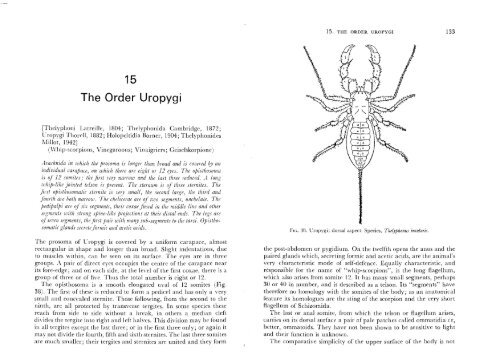You also want an ePaper? Increase the reach of your titles
YUMPU automatically turns print PDFs into web optimized ePapers that Google loves.
15. THE ORDER UROPYGI 133<br />
15<br />
The Order Uropygi<br />
[Thelyphoni Latreille, 1804; Thelyphonida Cambridge, 1872;<br />
Cropygi Thorell, 1882; Holopeltidia Borner, 1904; Thelyphonides<br />
~fillot, 1942]<br />
(Whip-scorpions, Vinegaroons; Vinaigricrs; Geiselskorpione)<br />
<strong>Arachnida</strong> in which the prosoma is longer than broad and is covered by an<br />
individual carapace, on which there are eight or I 2 ryes. The opisthosoma<br />
is of 12 somitfs; the first W)' narrow and the last three A<br />
whip-like jointed telson is present. The sternum is of three sternites. The<br />
first opisthosomatic sternite is ve1y small, the second the third and<br />
fourth are both narrow. The chelicerae are of two undulate. The<br />
pedipalpi are<br />
their coxae fitsed in the middle line and other<br />
with spine-like projections at theu distal ends. The are<br />
pair with many sub-segmmts to the tarsi. Opistho<br />
. and acetic acids.<br />
The prosoma of C ropygi is covered by a uniform carapace, almost<br />
rectangular in shape and longer than broad. Slight indentations, due<br />
to muscles within, can be seen on its surface. The eyes are in three<br />
groups. A pair of direct eyes occupies the centre of the carapace near<br />
its fore-edge; and on each side, at the level of the first coxae, there is a<br />
group of three or of Thus the total number is eight or 12.<br />
The opisthosoma is a smooth elongated oval of 12 somites (Fig.<br />
38). The first of these is reduced to form a pedicel and has only a very<br />
small and concealed sternite. Those following, from the second to the<br />
ninth, are all protected by transverse tergites. In some species these<br />
reach from side to side without a break, in others a median cleft<br />
divides the tergite into right and left halves. This diYision may be found<br />
in all tergites except the last three; or in the first three only; or again it<br />
may not divide the fourth, fifth and sixth sternites. The last three somites<br />
are much smaller; their tergites and sternites are united and they form<br />
FIG. 38. e ropygi; dorsal aspect. Species, Thelyphonus insularis.<br />
the post-abdomen or pygidium. On the twelfth opens the anus and the<br />
paired glands which, secreting formic and acetic acids, are the animal's<br />
very characteristic mode of self-defence. Equally characteristic, and<br />
responsible for the name of "whip-scorpions", is the long flagellum,<br />
which also arises from somite 12. It has many small segments, perhaps<br />
30 or 40 in number, and is described as a telson. Its "segments" have<br />
therefore no homology with the somites of the body; as an anatomical<br />
feature its homologues are the sting of the scorpion and the very short<br />
flagellum of Schizomida.<br />
The last or anal somite, from which the telson or flagellum arises,<br />
carries on its dorsal surface a pair of pale patches called ommatidia er,<br />
better, ommatoids. They have not been shown to be sensitive to light<br />
and their function is unknown.<br />
The comparative simplicity of the upper surface of the body is not















